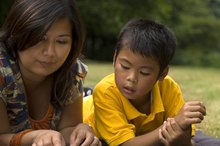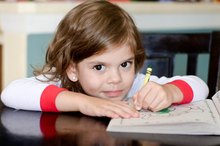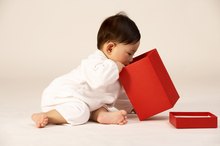Games for Cognitive Development During Early Childhood
**During your child's early years, he will learn quickly, and much of that learning is achieved through play, according to Education.com 12.
You can facilitate your child's learning by playing games with him so that he will want to practice his learning again and again. ** Through simple childhood games, you and your child can have fun while building his cognitive development.
Hiding and Memory Games
To help your baby understand object permanence -- the concept that objects continue to exist even when they are unseen -- hide a favorite toy under a blanket and encourage him to look for it. When your child is a toddler, introduce the game of Hide-and-Seek by hiding toys. Teach him to count to 10 while you hide the toy, and then let him look for it.
Use phrases such as, "Have you looked under the chair?" or "Maybe it is behind the curtain" to reinforce positional words.
Once your child is a preschooler, you can begin playing a memory matching game using cards that have pairs of identical pictures. Begin with just four or five pairs of cards turned face down and have him turn them over two at a time, looking for a match. As his memory increases, you can include more cards in your game. When he reaches school age, make the cards using letters, numbers or simple sight words.
- To help your baby understand object permanence -- the concept that objects continue to exist even when they are unseen -- hide a favorite toy under a blanket and encourage him to look for it.
Sorting Games
Galloping Activities for Children
Learn More
Young children are learning to recognize similarities and differences among objects.
According to the Kansas Department of Education, older infants can begin using toys that have parts that fit together, such as a shape sorter or simple puzzles to begin matching like-shapes 1. Toddlers and preschoolers will enjoy sorting their toys into categories by color or size as they play, so encourage your child by saying things such as, "Let's see if we can find all the blue cars and put them together."
You can teach your child lessons in practical situations. For example, you can let him help out with the laundry by asking him to help you sort the clothes into piles by color or by which family member they belong to. Once your child has sorted objects into categories, encourage him to count the objects and compare which group has more items. When he is an older preschooler, he will be able to sort objects by function, such as "things that fly" or "things we eat." Give your child several household objects and encourage him to sort them into the categories he chooses.
- Young children are learning to recognize similarities and differences among objects.
- According to the Kansas Department of Education, older infants can begin using toys that have parts that fit together, such as a shape sorter or simple puzzles to begin matching like-shapes 1.
Card Games
A deck of cards can be used for several different learning games with children of all ages. Toddlers can use them to match the suits or they can sort them by color.
Preschoolers who are learning to count and recognize numbers can use them to sequence the numbers found on the cards. Older preschoolers have more number sense and can compare which number is greater.
To play a simple comparing game, divide a deck of cards in half and give one-half to each player. Have both players turn over the top card from their pile and lay it on the table. Looking at the two numbers, have the players decide which one is 'more.' The player with the higher card will then place both cards in his pile. Continue playing until one player has collected all of the cards. **When your child reaches elementary school, he may be ready to use some rules of addition while playing a variation of this game.
** Have players turn over two cards and add the numbers together. The player with the higher sum will win all the cards.
- A deck of cards can be used for several different learning games with children of all ages.
- Looking at the two numbers, have the players decide which one is 'more.'
Movement Games
Activities to Promote Perceptual & Motor Skills
Learn More
Learning doesn't have to take place while sitting down or being quiet.
Let your child fulfill his need to move by playing some fun games outside. You can practice counting and number recognition with a game of hopscotch. Younger children can simply count as they hop on each square, while your older preschooler can find a number you call out.
You can use sidewalk chalk for a shape-recognition game that will help your child follow multi-step directions. Draw several large shapes on the ground using a variety of colors.
Then call out instructions for how your child should move to each shape.
For instance, "Hop to the blue triangle," or "Skip to the purple circle." He will be practicing his listening skills while burning off energy.
- Learning doesn't have to take place while sitting down or being quiet.
- Younger children can simply count as they hop on each square, while your older preschooler can find a number you call out.
Related Articles
References
Writer Bio
Stacey Chaloux is an educator who has taught in both regular and special education early childhood classrooms, as well as served as a parent educator, teaching parents how to be their child's best first teacher. She has a Bachelor of Science in education from the University of Missouri and a Master of Education from Graceland University.









